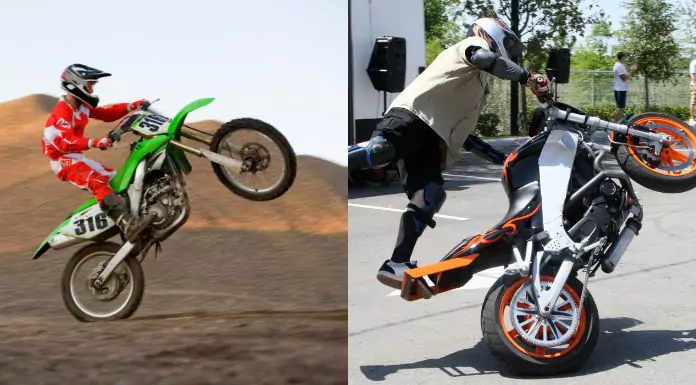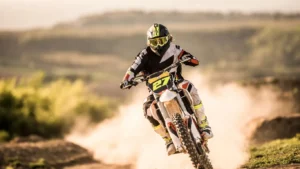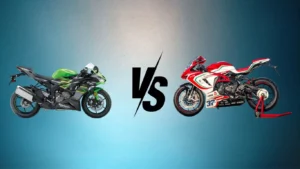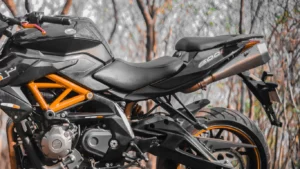Street bikes and dirt bikes are two-wheeled bikes. Some of these differences are physically noticeable, while others are more pronounced in structure and material.
Dirt bike enthusiasts love the experience of an adrenaline rush and fresh air while driving. Innumerable engineers have spent years perfecting these different types of vehicles so riders can experience superior performance. Street bikes and dirt bikes also have several types.
The essential difference between the two is that street bikes suit the road and dirt. Other differences are below.
What are the significant differences between a street bike and a dirt bike?
You are going to see the differences on the basis of several aspects:
1. Size and weight
Size is one of the most noticeable differences between these two bikes. Dirt bikes are small and usually come with the essentials to make them accessible for the rider to operate.
It is challenging to ride on a dirt bike’s tracks. Riders may even have to use their power to overcome certain hurdles. Most dirt bikes are single-cylinder and have a smaller displacement, making them more suitable for uneven roads than street bikes.
Street bikes share the road with large and heavy vehicles. It can be challenging to overcome the drag of a passing car, so a more robust machine is needed to secure the rider to the ground.
Small fuel tank is also helpful in making dirt bikes lightweight which is an important features and it is the most required thing for a dirt bike. On the other hand street bikes have to ride a long way so it comes with larger fuel tank.
2. Tires
The tires attached to the bikes represent the terrain for which they have a unique design. Off-road tires are designed to increase traction on surfaces such as gravel and dirt.
The tires are primarily knotted in large blocks and empty areas, propelling the bike to scratch soil, mud, and sand.
The tires are also narrower, giving the carcass more flexibility. You can feel this awkward nature of your bike when you turn the corner and feel the tires fidgeting. The street tires have a smooth, rounded shape with no space. Engineers try to expose as much rubber as possible to improve grip on the road.
The tread pattern diverts water from the street bike’s tires but does not work with mud, sand, or snow.
Dual sports tires usually have a percentage that reflects how biased they are for off-road or on-road use.
3. Suspension
The suspension handles damping impact. The more impact the bike has to absorb, the looser the rest. Dirt bikes have to overcome many obstacles, so they make them with spring shock absorbers and hydraulic tubes to absorb shocks.
The distance travelled by these bikes is typically 12 inches or more. Too many suspensions can make riding on the road uncomfortable and even bottom out when riding on the road.
The racing bike can absorb minor irregularities and imperfections while providing a comfortable ride. Suspension travel is typically a few inches, so the bike can overcome simple obstacles like potholes.
4. Sitting position
You may not know the different sitting positions required to ride your bike. When you look at dirt bike competitions, you often see riders running over the hurdles that have risen.
The seat tends to lean forward, allowing the rider to make quick and efficient adjustments.
You sit upright on an off-road bike and always put your feet directly underneath when standing.
The Adventure Bike has a trendy design due to its gentle wrist and back seating position. Dirt bikes move the rider forward in the wind and move their feet up and down, in turn, to encourage greater tilt angles.
This position is ideal for off-road activities but can be uncomfortable for extended periods if the wind does not press against your chest.
Dirt bike handlebars are located at the bottom of the body for maximum visibility and control.
On the road bike, the seats are placed further back to allow the rider to relax. It minimizes stress on the rider’s joints and puts the spine in a natural position. Riders often have to stop at traffic lights, allowing them to ride comfortably for extended periods.
5. Brake
Braking force compresses the front suspension and stops the ride. The bike’s power is directly related to the speed and weight of the bike.
Street bikes usually move fast and are heavy. Therefore, the bike needs a more robust braking system. Street bikes also have excellent traction from the tires. In other words, more braking force can be directed to the sidewalk.
When the road bike is ridden off-road, the brakes lock the tires quickly because they are on a low-traction surface.
Dirt bikes usually come with a small brake disc; some bikes may have only one disc on the front.
Dirt bikes typically rely on the front capacity to fire most of their braking power, but more rear braking can be used on dirt roads.
Tank It is a well-known fact that the larger the tank, the more fuel it can hold. A long journey requires a huge fuel tank. Dirt bikes usually don’t venture far and have a small fuel tank.
The large tank only adds unnecessary weight, but ideally, the dirt bike should be as light as possible. Racing bikes are suitable for long-distance rides, so the tank will be more significant.
The touring bike is perfect for long-distance trips. However, scooters and scooties are a strange category of street bikes because they travel short distances and have a smaller fuel tank.
6. Frame
As mentioned earlier, dirt bikes are smaller than on-road bikes due to their lighter weight and more petite frames.
Dirt bikes are made of sturdy and stable metal. Street bikes are also more fashionable, and metal enables all aesthetics.
7. Clutch
The street bike is designed to move comfortably at highway speeds and can reach up to three digits when equipped with an ample gas supply. Riders usually do not need to slip the clutch.
The clutch may be disengaged momentarily during an upshift and used in conjunction with acceleration to downshift.
On dirt bikes, the rider prefers to stay in the same gear and uses the clutch to speed up, so he makes heavy use of the grip.
Dirt bike riding generally requires slow manoeuvring, and instead of shifting gears and controlling speed with a throttle lever, keeping the throttle lever constant and using the clutch to control the ride to the wheels is much easier.
8. Steering
When riding a street bike, you don’t have to do a lot of steering to control the bike. You can’t even mess with the handlebars on a dirt bike before touching the tank.
Major steering interventions are only practical when manoeuvring in traffic or at parking speeds. In many cases, you can turn the racing bike and take turns simply by leaning in the desired direction.
First, of course, you’ll have to rely on the dirt bike, but most of the time, you’ll have to overcome the ruts and control the handlebars. The dirt bike is designed with wide handlebars, providing more leverage and allowing the tires to rotate further left and right.
Dirt bikers often use the handlebars to put their feet down to stabilize the balance of the bike.
9. Gearbox
Racing bikes are generally designed to move comfortably at highway speeds, with a solid throttle for easy access to three-digit numbers.
Even street-legal dirt bikes are designed to optimally apply torque in a lower gear to jump to the top of steep hills and get out of mud and sand.
The final translation is generally the change that distinguishes street-legal and dirt bikes, as the manufacturer wants to cross the freeway.
Dirt Bike and Street Bike Safety
Each bike type significantly differs in how they approach safety.
Both bikes can be dangerous, but the most critical safety factor is training in riding techniques, attitudes, and reactions in certain situations.
Learning the proper riding techniques is easier on dirt bikes than on street bikes.
Off-road skills are better transferred to the road than visa bars. Wearing proper riding equipment is essential, but the goal is to prevent catastrophic falls.
What is safer?
It depends on where you are riding, your experience, and your attitude.
Let’s compare the two scenarios.
You are an experienced rider who rides a bike on a dry country road and follows the law.
You are a new dirt bike rider just starting motocross and don’t understand all the etiquette rules when riding on an MX track.
Scenario # 1 is safer in most cases because it is much less risky. There is little traffic to worry about, knowing how a bike works on public roads and doing nothing stupid.
Scenario # 2. Riding a dirt bike for the first time is scary enough, but riding a motocross track as a beginner is a disaster recipe. There are two reasons for you and probably for other riders (perhaps even bystanders!).
It’s not hard to say who a beginner is (unfortunately, I was one a few years ago on the MX).
- You are not confident in your riding skills and control your bike on the race track. Most dirt bike trails are exponentially more challenging for riders. They have to do backflips, jumps, etc.
- Unless you have experience riding on a racetrack, it can be very tough for you to ride with experienced riders.
After all, it depends on your knowledge and experience and how much wisdom you have to apply that experience or restrain what you can’t do yet.
Are Dirt bikes and street bikes street legal?
A quick comparison of the two bikes shows that the Street Legal Dirt Bike is a dual sports bike that is registered and covered, so you can legally ride it on the road.
Due to the steering geometry, street-legal dirt bikes are more accessible than slower street bikes due to the steering geometry, making them easier to bend. Dual sports also have a more relaxed riding position than most road bikes.
However, if you want to ride faster or more aggressively in the corners, street bikes are easier to ride and have better traction as they have specially designed tires for tarmac riding.
The steering geometry of the street bike increases stability (fewer cramps) even at high speeds.
The Street Regal or Dual Sport Dirt Bike shines on the days when you want to ride the road and dirt on the same ride. Whether it’s a gravel road or a simple single trail, you can jump from asphalt to the terrain without any changes and still feel good.
Can I ride a dirt bike on the road?
Most state or city laws prohibit legal riding on the road unless a dirt bike is registered and follows the local terms. It is where dual sports bikes come into play.
If you need to ride the city streets to get to your local bridle pass, you will need to register a dirt bike or transport in another vehicle.
Street and dirt bikes need various skills.
For example, road cornering: modern riding skills are hanging from the seat. On the other hand, when riding a dirt bike off-road, you need to put your butt and weight (usually) on the outside of the seat.
These techniques are simple, but switching from one to the other can be difficult after years of riding a bike.
In addition, it is difficult for you to break this habit because the memory of this muscle is deeply rooted in your body.
So, what is the easiest way to avoid falling and getting injured by riding a dirt bike safely and confidently? If you ask this question, you are precisely the rider who can learn it in an driving school.
Wrapping Up
Dirt and street bikes are entirely different adventures. The same physics applies to the structure of street and dirt bikes, but with additional optimizations for each terrain.
Essential functions such as braking, clutch connection, acceleration, and cornering are also designed differently. Riding a dirt bike may be the same as riding a street bike, but riding a bike like a dirt bike is not recommended.
Dirt bikes are usually large and have flat handlebars. The ground clearance is high because the rider needs to see clearly around him. The tires are designed to dig into the surface and knock back everything that doesn’t stick.
Thanks to the forward-leaning seats, riders often ride their bikes. Road bikes, however, are heavy for stability and robustness. Road wheels need to be placed more on the ground as they interact with large vehicles on the road.
It is made of metal for added strength and style. There are also bikes on the market that specialize in exploration and commuting.






